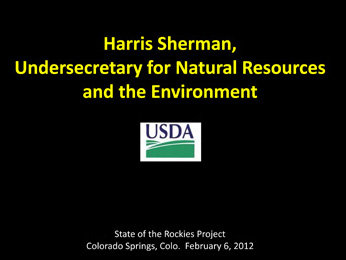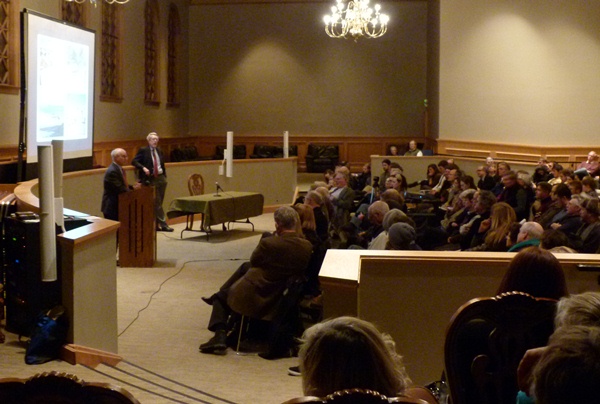Whether we turn on a faucet in Los Angeles, Denver, or Phoenix, the water that flows out of it depends on the Colorado River for its supply. And the Colorado River depends on national and private forests as its source, a 1964 Colorado College graduate who works for the Obama administration said during February’s 2011-2012 Monthly Speaker and Conference Series.
Sponsored by Colorado College’s State of the Rockies Project, the event was held Monday, Feb. 6, in the Gates Common Room of Palmer Hall on the CC campus. This sixth and final Speaker Series was as well attended as previous presentations, drawing about 175 students, faculty and members of the general public.
The series is titled “The Colorado River Basin: Agenda for Use, Restoration and Sustainability for the Next Generation,” and has featured experts talking for the past six months about issues surrounding the Colorado River. Topics have ranged from legal problems regarding water rights and allocations to engineering challenges going into the future.
The February event presented CC alum Harris D. Sherman, the U.S. Department of Agriculture’s Under Secretary for Natural Resources and the Environment. In that position, he oversees the U.S. Forest Service and its 50,000 employees, and the Natural Resources Conservation Service. The Denver native previously served under Gov. Bill Ritter as Executive Director of Colorado’s Department of Natural Resources.
During his presentation “Healthy Forests for the Colorado River Basin,” Sherman said water from the Colorado River and other rivers in the nation rely on good forest management.
“Our ability to protect this green infrastructure is every bit as important as our ability to build dams, canals, water treatment plants and other infrastructure,” he said. “Most people don’t realize that half of the water we drink comes from national forests, along with state and private forests.”
Sherman said 66 million people get their water from national forests, including 27 million along the Colorado River Basin.
But the U.S. Forest Service is facing a host of challenges in managing its 155 forests:
- Climate change has brought drought conditions in southern and western states and record precipitation in the northern tier, resulting in massive wildfires, flooding and erosion. The trend is expected to persist: Precipitation in the Colorado River Basin is running 35 percent to normal;
- Catastrophic wildfires are mounting in size – Texas, New Mexico and Arizona had the largest wildfires in history last year. In the past decade, nine states have had record-setting fires, including Colorado’s Hayman Fire in 2002. The amount of annual burned acreage continues to increase, from 7 million in 2000 to 9 million in recent years, with predictions of excesses of 10 to 15 million, depending on the drought. Wildfires can adversely affect wildlife, erosion, flooding, tourism and recreation;
- Many homes abut forest land. Colorado leads the pack with 341,175 homes lying in what’s called a wildland-urban interface.
- Money is tight, and there are an estimated 65 to 80 million acres of national forest land needing restoration. Another 325 million acres of state and private forests fall into that category. Restoration costs $200 to $2,000 per acre, depending on the method, from prescribed burns to thinning techniques using machinery.
- Warmer winters have led to the proliferation of the bark beetle, which has led to the largest epidemic in history. The destructive beetle has impacted 41 million acres of forest land. Colorado has been hit the hardest, with 6.6 million acres affected by the disease. In addition to aesthetics, health and safety issues are arising from the destruction.
Despite the challenges, Sherman said the U.S. Forest Service is addressing the problems through creative solutions. Partnerships and collaborations are a key factor. The city of Denver, for example, is paying the Forest Service $17 million to work on 40,000 acres of national forest land to help protect five watersheds.
“We call this payment for eco-systems services. The Hayman Fire resulted in tremendous erosion, which almost brought Denver’s water system to its knees. They had major problems with filtration and water treatment issues,” Sherman said. “Denver’s now decided to be proactive.”
The Forest Service also is looking at how to create new markets for wood products. Because the housing and pulp and paper industries do not use as much wood as in the past, there aren’t as many avenues to sell trees that have been thinned or expired. One possibility is to convert wood chips to electricity. But Sherman said that hasn’t yet reached the point where it’s economically feasible.
Other efforts include educating homeowners to create clear areas between their houses and forest land and working with environmental groups about the benefits of thinning forests and replanting.
During a question-and-answer session, a student asked whether the Forest Service views fires as a natural process that has benefits. Sherman said the philosophy that all fires are bad has changed in recent years.
“For a long time, the Forest Service didn’t let fires burn because they were not good. The result: We’ve ended up with these vast, dense, monolithic forests, which is partly why we have the condition we have today. Fire has to be carefully controlled; we do 3.5 million acres a year of prescribed fires. But when you have a fire near a community or an area that has a high amount of recreation, you have to be careful. When they get out of hand, you have an unfortunate situation. It’s a balancing act.”
The monthly Speaker Series will culminate with the State of the Rockies Project annual conference, April 9-10, on the CC campus. A stellar lineup of officials working on the future management of the Colorado River Basin will give presentations, and organizers will release the annual Rockies report card.
Check the Rockies website, http://www2.coloradocollege.edu/stateoftherockies/conference.html, for more information regarding the conference.

